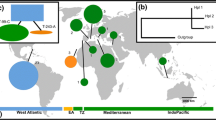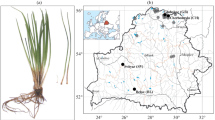Abstract
Galdieria is a photosynthetic unicellular protist, inhabiting thermoacidic environments around the world. The synchronicity of these thermoacidophilic algae with their extreme habitats makes them unable to thrive in different ecological conditions. The genetic structure of Galdieria populations has not yet been studied. In this report, the level of genetic diversity and structure of five Galdieria populations from Iceland were assessed through both random amplified polymorphic DNA (RAPD) markers, and a partial calmodulin gene fragment (previously used to assess the population structure of these extremophilic algae). The level of population differentiation from both the RAPD and CaM markers was estimated using PLP, percentage of polymorphic loci; H, the expected heterozygosity; I, Shannon’s information index, Ks, Kst. The migration ability of the Galdieria populations was suggested by the high level of genetic variations scored within each Galdieria population and by the small number of polymorphisms detected between the different Icelandic populations. The low genetic diversity between the two species was highlighted by RAPD and calmodulin markers, suggesting for the first time an interspecific genetic flow between species as strategy to evolve in stressful environments.




Similar content being viewed by others
References
Albertano P, Ciniglia C, Pinto G, Pollio A (2000) The taxonomic position of Cyanidium, Cyanidioschyzon and Galdieria: an update. Hydrobiologia 433:137–143
Bardakci F (2001) Random amplified polymorphic DNA (RAPD) markers. Turk J Biol 25:185–196
Brock TD (1978) The genus Cyanidium. In: Starr PM (ed) Thermophilic mi-croorganisms and life at high temperatures. Springer, New York, pp 255–301
Cennamo P, Ciniglia C (2017) The algal diversity in the Phlegrean Fields (Campania, Italy) archeological districts. UPLanD 2(2):97–106
Cennamo P, Marzano C, Ciniglia C, Pinto G, Cappelletti P, Caputo P, Pollio A (2012) A survey of the algal flora of anthropogenic caves of Campi Flegrei (Naples, Italy) archeological district. J Cave Karst Stud 74(3):243–250
Ciniglia C, Yoon HS, Pollio A, Pinto G, Bhattacharya D (2004) Hidden biodiversity of the extremophilic Cyanidiales red algae. Mol Ecol 13:1827–1838
Ciniglia C, Cennamo P, De Stefano M, Pinto G, Caputo P, Pollio A (2007) Pinnularia obscura Krasske (Bacillariophyceae, Bacillariophyta) from acidic environments: characterization and comparison with other acid-tolerant Pinnularia species. Fundam Appl Limnol 170(1):29–47
Ciniglia C, Yang EU, Pollio A, Pinto G, Iovinella M, Vitale L, Yoon HS (2014) Cyanidiophyceae in Iceland: plastid rbcL gene elucidates origin and dispersal of extemophilic Galdieria sulphuraria and G. maxima (Galdieriaceae, Rhodophyta). Phycologia 53:542–551
Cozzolino S, Caputo P, De Castro O, Moretti A, Pinto G (2000) Molecular variation in Galdieria sulphuraria (Galdieri) Merola and its bearing on taxonomy. Hydrobiologia 433:145–151
Cui C, Li Y, Liu Y, Li X, Luo S, Zhang Z, Wu R, Liang G, Sun J, Peng J, Tian P (2017) Determination of genetic diversity among Saccharina germplasm using ISSR and RAPD markers. CR Biol 340(2):76–86
De Castro O, Sepe F, Di Maio A, Cennamo P, De Luca P, Gianguzzi L, Menale B (2013) Genetic structure in the paleoendemic and endangered Petagnaea gussonei (Spreng.) Rauschert (Saniculoideae, Apiaceae) and implications for its conservation. Plant Syst Evol 299:209–223
El Mousadik A, Petit RJ (1996) High level of genetic differentiation for allelic richness among populations of the argan tree [Argania spinosa (L.) Skeels] endemic of Morocco. Theor Appl Gen 92:832–839
Excoffier L, Smouse PE, Quattro JM (1992) Analysis of molecular variance inferred from metric distances among DNA haplotypes: application to human mitochondrial DNA restriction data. Genetics 131:479–491
Excoffier L, Laval G, Schneider S (2005) Arlequin (version 3.0): an integrated software package for population genetics data analysis. Evol Bioinf Online 1:47–50
Finger A, Klank C (2010) Molecular methods: blessing or curse? In: Habel JC, Assmann T (eds) Relict species: phylogeography and conservation biology. Springer, Berlin Heidelberg, pp 309–320
Glockner G, Rosenthal A, Valentin K (2000) The structure and gene repertoire of an ancient red algal plastid genome. J Mol Evol 51:382–390
Gomez PI, Gonzalez MA (2004) Genetic variation among seven strains of Dunaliella salina (Chlorophyta) with industrial potential, based on RAPD banding patterns and on nuclear ITS rDNA sequences. Aquaculture 233:149–162
Gross W, Heilmann I, Lenze D, Schnarrenberger C (2001) Biogeography of the Cyanidiaceae (Rhodophyta) based on 18S ribosomal RNA sequence data. Eur J Phycol 36:275–280
Hudson RR (2000) A new statistic for detecting genetic differentiation. Genetics 155:2011–2014
Hudson RR, Boos DD, Kaplan NL (1992) A statistical test for detecting geographic subdivision. Mol Biol Evol 9:138–151
Keithellakpam OS, Oinam AS, Thingujam I, Oinam G, Nath TO (2017) Morphology and RAPD analysis of potential cyanobacterial isolates of Loktak Lake, the only largest freshwater lake in the North-East India. J Microbiol Biotechnol Res 5(2):46–53
Lewontin R (1972) The apportionment of human diversity. Evol Biol 6:381–398
Lynch M, Milligan BG (1994) Analysis of population structure with RAPD markers. Mol Ecol 3:1–99
Mantel N (1967) The detection of disease clustering and a generalized regression approach. Cancer Res 27:209–220
Merola A, Castaldo R, De Luca P, Gambardella R, Musacchio A, Taddei R (1981) Revision of Cyanidium caldarium. Three species of acidophilic algae. Plant Biosys 115:189–195
Nei M (1987) Molecular evolutionary genetics. Columbia University Press, New York
Peakall R, Smouse PE (2006) GENALEX 6: genetic analysis in Excel. Population genetic software for teaching and research. Mol Ecol Notes 6:288–295
Petit RJ, El Mousaidik A, Pons O (1998) Identifying populations for conservation on the basis of genetic markers. Conserv Biol 12:844–855
Pinto G, Albertano P, Ciniglia C, Cozzolino S, Pollio A, Yoon HS, Bhattacharya D (2003) Comparative approaches to the taxonomy of the genus Galdieria Merola (Cyanidiales, Rhodophyta). Cryptogamie Algol 24:13–32
Pinto G, Ciniglia C, Cascone C, Pollio A (2007) Species composition of Cyanidiales assemblages in Pisciarelli (Campi Flegrei, Italy) and description of Galdieria phlegrea sp. nov. In: Seckbach J (ed) Algae and Cyanobacteria in Extreme Environments. Springer, The Netherlands, pp 387–397
Podani J (2001) SYN-TAX (2000) Computer program for data analysis in ecology and systematics for WINDOWS 95, 98 & NT. Scientia Publishing, Budapest
Ronquist F, Huelsenbeck JP (2003) MRBAYES 3: bayesian phylogenetic inference under mixed models. Bioinformatics 19:1572–1574
Schönknecht G, Chen WH, Ternes CM, Barbier GG, Shrestha RP, Stanke M, Brautigam A, Baker BJ, Banfield JF, Garavito RM, Carr K, Wilkerson C, Rensing SA, Gagneul D, Dickenson NE, Oesterhelt C, Lercher MJ, Weber AP (2013) Gene transfer from bacteria and archaea facilitate evolution of an extremophilic eukaryote. Science 8:1207–1210
Sentsova OY (1991) Diversity of acido-thermophilic unicellular algae of the genus Galdieria (Rhodophyta, Cyanidiophyceae). Botanich Zhur 76:69–79
Toplin JA, Norris TB, Lehr CR, McDermott TR, Castenholz RW (2008) Biogeographic and phylogenetic diversity of termoacidophilic Cyanidiophyceae in Yellowstone National Park, Japan and New Zealand. Appl Environ Microbiol 74:2822–2833
Valatka S, Antia M, Tapani YM (2000) Analysis of genetic diversity of Furcellaria lumbricalis (Gigartinales, Rhodophyta) in the Baltic Sea by RAPD-PCR technique. Phycologia 39(2):109–117
Williams JGK, Kubelik AR, Livak KJ, Rafalski JA, Tingey SV (1990) DNA polymorphisms amplified by arbitrary primers are useful as genetic markers. Nucl Acid Res 18:6531–6535
Yeh FRC, Yang RC, Boyle TBJ, Ye ZH, Mao JX (1997) POPGENE, the user-friendly shareware for population genetic analysis, Molecular Biology and Biotechnology Centre, University of Alberta, Edmonton. http://www.ualberta.ca/~fyeh/popgene_info.html/
Yoon HS, Hackett JD, Pinto G, Bhattacharya D (2002) The single, ancient origin of chromist plastids. Proc Natl Acad Sci USA 99:15507–15512
Yoon HS, Hackett JD, Ciniglia C, Pinto G, Bhattacharya D (2004) A molecular timeline for the origin of photosynthetic eukaryotes. Mol Biol Evol 21:809–818
Yoon HS, Müller KM, Sheath RG, Ott FD, Bhattacharya D (2006) Defining the major lineages of red algae (Rhodophyta). J Phycol 42:482–492
Acknowledgements
We are thankful to Dr Gudmundur Vidir Helgason for hospitality and laboratory support at the Sandgerdi Marine Centre (SMC). The stay at the SMC was supported by the program “Improving Human Potential: Access to Research Infrastructure” provided by the European Community. We are grateful to Prof. Antonino Pollio for the logistical support of the algal cultures which are maintained at the Algal Collection of University of Naples “Federico II”. Many thanks to Dr Rachael Oakenfull for the English editing of the manuscript. We are also grateful to Prof. Hwan Su Yoon for calmodulin gene sequencing, which was supported by the Korean Rural Development Administration Next-generation BioGreen21 (PJ009525), the National Research Foundation of Korea (MEST: 2014R1A2A2A01003588), and US National Science Foundation (DEB 1317114) to HSY.
Author information
Authors and Affiliations
Corresponding author
Rights and permissions
About this article
Cite this article
Eren, A., Iovinella, M., Yoon, H.S. et al. Genetic structure of Galdieria populations from Iceland. Polar Biol 41, 1681–1691 (2018). https://doi.org/10.1007/s00300-018-2308-3
Received:
Revised:
Accepted:
Published:
Issue Date:
DOI: https://doi.org/10.1007/s00300-018-2308-3




